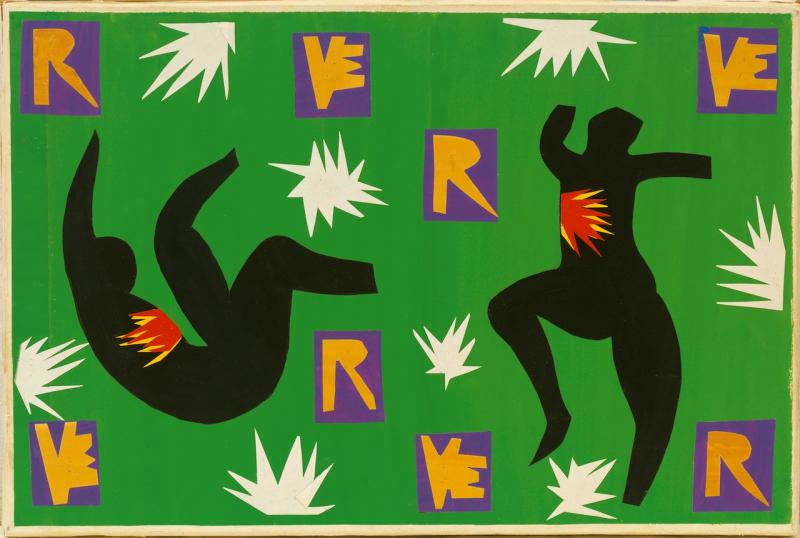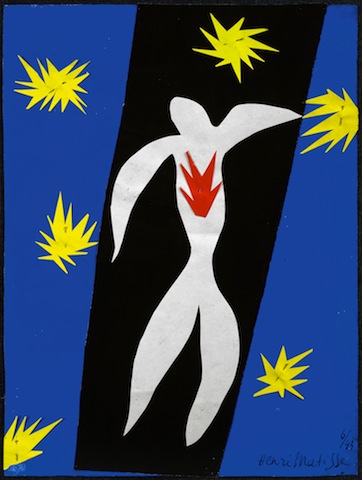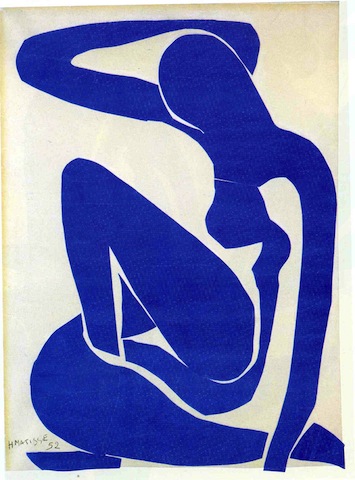Matisse: The Cut-Outs, Tate Modern | reviews, news & interviews
Matisse: The Cut-Outs, Tate Modern
Matisse: The Cut-Outs, Tate Modern
An irrepressible joy touched by pathos in the French modernist's late works

When it comes to the two vying giants of 20th century art we do – don’t we? – all fall into that cliché of two opposing camps. You have the seductions of colour and decorative form on the one hand and you have the more classical rigours of line on the other, the one exemplified by Matisse, the other by Picasso. It’s not an absolute demarcation – a line that’s never blurred (and Matisse had, of course, a very elegant line); just a profound difference in emphasis and sensibility.
Me? I’ve always gone for the head, not the eye, or indeed the heart. In other words, I’m in the Picasso camp. And when it comes to the late works of either artist, I’ve always found myself in sympathy with the old-age rage of Picasso. And not just with the fury, but the fear. Picasso, he was complicated. And it’s all there in his work.
The dichotomy of the head and the eye may also explain why it’s hard to love, rather than to simply admire, Picasso, and why it’s so easy to fall head over heels for Matisse. When something expresses itself with such an irrepressible joie de vivre, you fall in love with it. You can’t help yourself; it’s intoxicating. But there’s got to be something else there too. A chink where sadness and vulnerability creep in and make their shadowy presence felt, or else all that joy would be insufferable. There’s poignancy in Matisse’s late works, in those exquisite cut-outs that occupied him so intensely in the remaining decade of his life and to which this exhibition is devoted, and it makes the joy even sweeter. As in life, so in art.
Just look at the “maquettes” for Jazz, the paper cut-outs made during the war and finally published in book form by the important art publisher Tériade (who also came up with the title for this collection of falling and dancing figures) in 1947. By that time Matisse had been living in Vence for four years, having fled there from Nice to escape the bombing in 1943. He was already very ill and infirm and Jazz was the fullest expression to date of his simple cut-out technique, developed – though for years used as a tool to compose his paintings – because he could no longer hold a brush effectively.
Under his close supervision assistants painted the paper in bold, bright colours using gouache to which he, with surprising dexterity, applied a pair of scissors – hence “drawing with scissors”, though as the term “maquette” suggests, the cutting is perhaps closer to sculpting, since you’re also physically taking away as well as following a line. With that, the forms were then pinned to a surface, often in a process of constant revision, before finally being laid down with glue, or simply left as they were in his studio (film footage allows us to watch this process in action).
 Here, a number of the original Jazz cut-outs are shown with their printed versions lined in glass cases in one long gallery, and what’s immediately evident is how much the printed versions have lost in translation, their vivacity leached by the mechanical process. Colours are flattened, while forms have lost their layered rough-edgedness. Their “sensitivity” has been forfeited, as Matisse observed. I can’t overestimate what a pleasure it is to see these in the raw: here we find Icarus, a figure white against black as if an irradiated imprint in the cosmic darkness, with jagged red “flames” bursting through his chest. The jagged heart-burst is echoed in the forms of fiery yellow stars against a calm midnight blue. (Pictured above: The Fall of Icarus, 1943; maquette with pins)
Here, a number of the original Jazz cut-outs are shown with their printed versions lined in glass cases in one long gallery, and what’s immediately evident is how much the printed versions have lost in translation, their vivacity leached by the mechanical process. Colours are flattened, while forms have lost their layered rough-edgedness. Their “sensitivity” has been forfeited, as Matisse observed. I can’t overestimate what a pleasure it is to see these in the raw: here we find Icarus, a figure white against black as if an irradiated imprint in the cosmic darkness, with jagged red “flames” bursting through his chest. The jagged heart-burst is echoed in the forms of fiery yellow stars against a calm midnight blue. (Pictured above: The Fall of Icarus, 1943; maquette with pins)
Falling, tumbling figures crop up again up in a series of cut-outs made for the cover of a magazine called Verve, again published by Tériade (see main picture). For me, these are among the most affecting works here. They are full of pathos, but as far from wiltingly sentimental as you can get. Their heat, their energy contrasts with the elegant and formidable Blue Nudes. (Pictured below: Blue Nude I, spring 1952)
 The hang is beautiful. In one room we find an arresting “salon-hang” of smaller cut-outs, while larger works, with their “bleached-white” silhouettes against greys, burst with marine life. As one progresses, the bigger the works, often the more decorative the scheme, and I’m afraid I’m always left cold by his designs for the Chapel of the Rosary at Vence. A room is dedicated to both the discarded and the final cut-out designs for this tiny church in south-east France, including the work for its stained-glass windows. For me, the show ends with an overly decorative whimper, with another stained-glass design, this time for the Time-Life Building in New York.
The hang is beautiful. In one room we find an arresting “salon-hang” of smaller cut-outs, while larger works, with their “bleached-white” silhouettes against greys, burst with marine life. As one progresses, the bigger the works, often the more decorative the scheme, and I’m afraid I’m always left cold by his designs for the Chapel of the Rosary at Vence. A room is dedicated to both the discarded and the final cut-out designs for this tiny church in south-east France, including the work for its stained-glass windows. For me, the show ends with an overly decorative whimper, with another stained-glass design, this time for the Time-Life Building in New York.
But before we get there, we’ve already arrived at the final simplicity of the Tate’s own The Snail, 1953, made a year before the artist’s death and shown with its sister compositions, Memory of Oceania (MoMA, New York) and Large Composition with Masks (National Gallery of Art, Washington), all originally conceived as one unified work. Just how long did it take him to determine The Snail’s final form? You wouldn’t want to rearrange a thing. It’s perfect.
Explore topics
Share this article
The future of Arts Journalism
You can stop theartsdesk.com closing!
We urgently need financing to survive. Our fundraising drive has thus far raised £49,000 but we need to reach £100,000 or we will be forced to close. Please contribute here: https://gofund.me/c3f6033d
And if you can forward this information to anyone who might assist, we’d be grateful.

Subscribe to theartsdesk.com
Thank you for continuing to read our work on theartsdesk.com. For unlimited access to every article in its entirety, including our archive of more than 15,000 pieces, we're asking for £5 per month or £40 per year. We feel it's a very good deal, and hope you do too.
To take a subscription now simply click here.
And if you're looking for that extra gift for a friend or family member, why not treat them to a theartsdesk.com gift subscription?
more Visual arts
 'We are bowled over!' Thank you for your messages of love and support
Much-appreciated words of commendation from readers and the cultural community
'We are bowled over!' Thank you for your messages of love and support
Much-appreciated words of commendation from readers and the cultural community
![SEX MONEY RACE RELIGION [2016] by Gilbert and George. Installation shot of Gilbert & George 21ST CENTURY PICTURES Hayward Gallery](https://theartsdesk.com/sites/default/files/styles/thumbnail/public/mastimages/Gilbert%20%26%20George_%2021ST%20CENTURY%20PICTURES.%20SEX%20MONEY%20RACE%20RELIGION%20%5B2016%5D.%20Photo_%20Mark%20Blower.%20Courtesy%20of%20the%20Gilbert%20%26%20George%20and%20the%20Hayward%20Gallery._0.jpg?itok=7tVsLyR-) Gilbert & George, 21st Century Pictures, Hayward Gallery review - brash, bright and not so beautiful
The couple's coloured photomontages shout louder than ever, causing sensory overload
Gilbert & George, 21st Century Pictures, Hayward Gallery review - brash, bright and not so beautiful
The couple's coloured photomontages shout louder than ever, causing sensory overload
 Lee Miller, Tate Britain review - an extraordinary career that remains an enigma
Fashion photographer, artist or war reporter; will the real Lee Miller please step forward?
Lee Miller, Tate Britain review - an extraordinary career that remains an enigma
Fashion photographer, artist or war reporter; will the real Lee Miller please step forward?
 Kerry James Marshall: The Histories, Royal Academy review - a triumphant celebration of blackness
Room after room of glorious paintings
Kerry James Marshall: The Histories, Royal Academy review - a triumphant celebration of blackness
Room after room of glorious paintings
 Folkestone Triennial 2025 - landscape, seascape, art lovers' escape
Locally rooted festival brings home many but not all global concerns
Folkestone Triennial 2025 - landscape, seascape, art lovers' escape
Locally rooted festival brings home many but not all global concerns
 Sir Brian Clarke (1953-2025) - a personal tribute
Remembering an artist with a gift for the transcendent
Sir Brian Clarke (1953-2025) - a personal tribute
Remembering an artist with a gift for the transcendent
 Emily Kam Kngwarray, Tate Modern review - glimpses of another world
Pictures that are an affirmation of belonging
Emily Kam Kngwarray, Tate Modern review - glimpses of another world
Pictures that are an affirmation of belonging
 Kiefer / Van Gogh, Royal Academy review - a pairing of opposites
Small scale intensity meets large scale melodrama
Kiefer / Van Gogh, Royal Academy review - a pairing of opposites
Small scale intensity meets large scale melodrama
 Jenny Saville: The Anatomy of Painting, National Portrait Gallery review - a protégé losing her way
A brilliant painter in search of a worthwhile subject
Jenny Saville: The Anatomy of Painting, National Portrait Gallery review - a protégé losing her way
A brilliant painter in search of a worthwhile subject
 Abstract Erotic, Courtauld Gallery review - sculpture that is sensuous, funny and subversive
Testing the boundaries of good taste, and winning
Abstract Erotic, Courtauld Gallery review - sculpture that is sensuous, funny and subversive
Testing the boundaries of good taste, and winning
 Edward Burra, Tate Britain review - watercolour made mainstream
Social satire with a nasty bite
Edward Burra, Tate Britain review - watercolour made mainstream
Social satire with a nasty bite
 Ithell Colquhoun, Tate Britain review - revelations of a weird and wonderful world
Emanations from the unconscious
Ithell Colquhoun, Tate Britain review - revelations of a weird and wonderful world
Emanations from the unconscious

Add comment